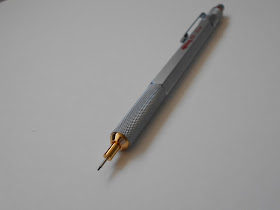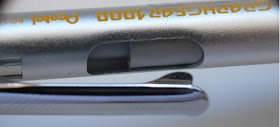Great title, huh?
Ok, so in a previous post I showed off my drafting pencil collection and wrote some personal notes of what I think about the Rotrings, Pentel and Kuru Toga.
Now it's time to show you another, more dark part of the story...one involving black drafting ink (Pulitzer nomination for this posting, I guarantee it)
I mentioned in a post a while back, that I found some Rotring Rapidograph ISO pens at a flea market. So I bought them, took them home, 'cause where else might I take them, then researched on how best to clean them and get them working again. Well, almost every article out there says you should soak them in some water for a day or two. So I did.
From the black stuff floating aroung, you can guess these pens were ridden hard and put away wet. As you might imagine, this isn't really the way to handle these, so after pulling on the pens so hard that I thought I'd break the plastic threads on them, I got the tips out and soaked them for 5 days in plain water. And same for the used ink wells. I'm stingy like that.
After repeated soakings, then tapping the botton on the table (really hard) to get all the crud out, then more soaking , I reached a point where I thought they were clean. But I was wrong....
So this is what a tip looks like. This is a 0.5mm one. And a dirty one at that. The brown part is the actual tip that goes in the pen and the ink covered thing with the needle on the left is the plunger that goes inside the tip. And as you might have guessed, all that dried ink shouldn't really be there. So I continued with more soaking and then cleaning the plunger with paper towels. The tip also went for another soaking.
I even tried to put them in some IPA for a few hours (I'm refering here to isopropanol alcohol, not beer)
Better, but still not there. The more I soaked them, the more dried ink came out in small little bits.
So the only thing I could do was just to keep at it until everything was shiny and clean. This tooks in total 7 days. 5 days of soaking and a whole weekend for the cleaning and putting everything back together.
After I gor everything squeaqy clean, assembling them was really easy. Add some ink cartridged from Rotring and job done
Now, there might be other like-minded people out there, so what follows is a step-by-step on how to take apart a Rotring for cleaning. Yeah, there's Youtube.... but unfortunately I never really saw someone actually take out the plunger from the tip. Hell, I didn't even know it was there. Imagine my surprise when it first came out of the tip.
Oh, and most of the videos show you the pens being rinsed with some water....then lighly dried with a towel. Well, ink that's beed dried for some years isn't really going to dissolve in water. Trust me on this one. The only good way is to wack it out of there.
First unscrew the pen and the well from the outer casing (the red thing that says Rotring on it)
Then unscrew the coller so that you're only left with the tip and the ink well
Now, to pull out the tip, screw it in the back of the casing, then pull on the ink well. Note, that if your pens were like mine and had the ink dried on it for some years, it'll take a lot of force to pull off the ink well. And by a lot I mean you'll get that "this thing is going to just break in my hands" feeling.
But don't worry.... if you pull on it a bit at a time, it'll come loose eventually. As an alternative, you can pull off the ink well just a bit, then soak the whole tip in some water for a few hours then try again.
Nearly there. There's one more thing to take care of. See that little black thing on the end of the tip? That has to also come off so that you can take out the plunger inside. Of course, if you have the ink caked in there, you'll need a lot of soaking and percussive maintenance until you can get that out.
And I leave the rest in your capable hands. After everything is as clean as your OCD will allow it, just put everything back together again. Oh, and don't forget to let the tip and plunger thoroughly dry.
And as a final word, make absolutely sure that every bit of dried ink is gone. If not, it'll just clog up the tip again. Though if that happens, you can use the plunger and ram it from the front of the tip to get things flowing again.
See you guys next time. Well, not see you...but... well, you know what I mean.



































